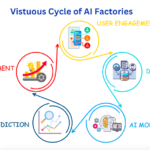
In the digital age, businesses are continually seeking strategies to stay competitive and innovative. A compelling approach to integrating Artificial Intelligence (AI) into business operations has been articulated by Harvard researchers Karim R. Lakhani and Marco Iansiti in their insightful book, Competing in the Age of AI. They introduce the concept of the “AI Factory,” a framework that systematically applies analytics and AI across a company’s processes. Here’s a closer look at the four essential components of this model, which can help traditional businesses transition into agile, data-driven enterprises.
1. Data Pipeline
The data pipeline is the bedrock of an AI-driven firm. It involves the meticulous collection, cleaning, integration, processing, and safeguarding of data. The objective here is to manage data in a way that is systematic, sustainable, and scalable. Effective data management ensures that the organization has access to reliable and timely data, essential for developing precise AI models that drive decision-making.
Case: Amazon’s data pipeline is vast and sophisticated, handling massive volumes of data collected from various sources, including customer transactions, browsing behaviors, seller interactions, and device usage (such as Kindle and Alexa). This data is systematically gathered, cleansed, and integrated across Amazon’s platforms, providing the foundational layer for its machine learning models. The pipeline ensures that data is accurate, timely, and secure, facilitating effective data-driven decision-making across the company.
2. Algorithm Development
At the core of the digital firm is algorithm development. These algorithms are pivotal, generating predictions about future states or actions that guide critical business operations. Continual refinement of these algorithms ensures they remain effective in driving the company’s strategic and operational decisions as they learn from new data and evolving market conditions.
Case: At the heart of Amazon’s innovation are its algorithms. Amazon uses machine learning algorithms for a variety of purposes, from product recommendations to dynamic pricing strategies. These algorithms are continuously updated with new data from the data pipeline to improve their accuracy. For instance, the recommendation engine not only helps customers find products they might like but also significantly drives Amazon’s revenue by increasing cross-sell and upsell opportunities.
3. Experimental Platform
An experimental platform within the AI factory serves as a test bed for new ideas and algorithmic predictions. It allows companies to assess the impacts of potential changes in a controlled environment, ensuring that any new strategies deliver the intended results before wide-scale implementation. This platform supports an iterative approach to innovation, crucial for maintaining relevance and efficacy in rapidly evolving markets.
Case: Amazon is known for its culture of experimentation, supported by its vast experimental platform that allows it to perform A/B testing at an unprecedented scale. This platform enables Amazon to test everything from minor changes in the user interface to major alterations in its recommendation algorithms. By testing these changes with a segment of users before a full rollout, Amazon can refine its offerings and ensure that modifications enhance the user experience and business metrics effectively.
4. Software Infrastructure
Finally, robust software infrastructure is what binds all the other components together. It provides the necessary technological support to deploy AI solutions effectively. This infrastructure must be scalable, flexible, and capable of integrating smoothly with internal and external systems. It ensures the seamless operation of data pipelines and algorithms and facilitates straightforward updates and enhancements.
Case: Amazon’s robust software infrastructure, which includes Amazon Web Services (AWS), supports all its internal systems as well as its customer-facing applications. AWS not only powers Amazon’s e-commerce platform but also serves as a backbone for the deployment of its AI and machine learning models. This infrastructure is scalable, reliable, and secure, allowing Amazon to efficiently manage its operations and innovate at speed. AWS itself is a leader in providing AI and machine learning services to other companies, further extending Amazon’s influence in the digital technology space.
Conclusion
By adopting the AI factory model, traditional businesses can transform into more dynamic entities capable of leveraging AI at scale. This shift not only boosts operational efficiencies but also positions companies well ahead of their competitors in adapting to market changes. More than just a technological upgrade, this model redefines a company’s foundational workflows to be centered around data and AI, fostering a proactive and adaptive business strategy.
In using these four components of the AI factory model, Amazon has been able to maintain its position as a leader in both e-commerce and technology. The company exemplifies how integrating data management, algorithm development, experimental testing, and a strong software infrastructure can lead to sustained innovation and competitive advantage in the digital age.
The AI factory is not just a theoretical construct but a practical roadmap for businesses aiming to harness the full potential of AI, ensuring they are not only participants but leaders in the digital economy.
#AI #ArtificialIntelligence #DigitalTransformation #AIFactory #DataScience #MachineLearning #BigData #AlgorithmDevelopment #TechInnovation #CloudComputing #AWS #AmazonAI #BusinessIntelligence #AITechnology #FutureOfWork


